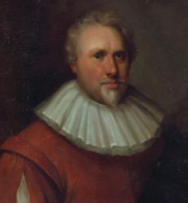 John Taylor was an English poet of Shakespearian times who became popularly known as “The Water Poet”, a nickname that he actually gave himself. This came about because of his profession as a waterman, operating an essential service on the rivers of London and Oxford at different times.
John Taylor was an English poet of Shakespearian times who became popularly known as “The Water Poet”, a nickname that he actually gave himself. This came about because of his profession as a waterman, operating an essential service on the rivers of London and Oxford at different times.
He was born on the 24th August 1578 in Gloucester, a city on the banks of the River Severn. During the early 1580s he moved to London where he took an apprenticeship with a waterman in Southwark. He was soon ferrying people across the river for a variety of pursuits, including visits to the theatres that were then predominantly on the south bank. At that time there was only one bridge spanning the Thames in London so these water “taxis” did good business. This was briefly interrupted during the latter years of the 16th century when he served in the Earl of Essex’s fleet on military service in Spanish waters.
Taylor made a success of life in the guild of Thames boatmen, eventually becoming clerk to the company and writing about it in the form of official reports and also in verse. He actually spent most of his life close to the Thames but, as a loyal supporter of King Charles I, he followed the royal court to Oxford in 1643 at the outbreak of the Civil War. Here he was given the prestigious title of Royalist Water Bailiff with responsibilities for keeping the city’s rivers clean and navigable. Public health was greatly affected by the cleanliness of river water and he had to ensure that nothing could prevent the free movement by water of ammunition, food and fuel for the King’s soldiers encamped around the city.
Taylor wrote much about the changing transport policies of the time, such as the ever increasing use of horse drawn carriages at the expense of water traffic. He wrote a piece in 1623 called The World Runnes on Wheeles, bemoaning the introduction of spring suspension systems on carriages that were seen as more efficient than slow moving boats. His poem An Arrant Thief (1622) was a plaintive cry on behalf of London boatmen who were losing their livelihoods and it is reproduced here:

Taylor’s literary output was considerable with, it is estimated, over 150 pieces of work being attributed to him. His often witty, sometimes crudely constructed poems and pamphlets were collected and published in 1630 under the title All the Workes of John Taylor the Water Poet. He was an inventive fellow, with a new “language” called Barmoodan being one of his innovations. He loved to observe people and their lives, noting down the activities they employed to distract themselves from life’s monotony (such as card games). An account of his findings was published in 1621 called Taylor’s Motto.
He was sometimes seen as an eccentric character who undertook risky ventures such as making his way to Scotland in 1618 with no money in his pocket, described in his published work Pennylesse Pilgrimage. On another occasion he set off from London on a journey down the Thames estuary in a boat made of paper with oars made of cane with two stockfish tied to them.
Much of his writing was produced for subscribers who had promised to support him in getting his work published. He was a relatively successful author and another interesting fact about his life is that he was one of the first to use palindromes in his work. An example of this, written in 1614, was

John Taylor died sometime during the year 1653, at the age of 75.

